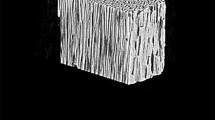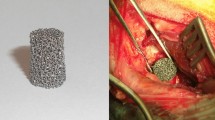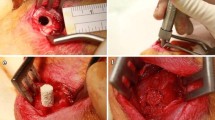Summary
This study describes the response of human cancellous bone when autologous bone chips are added at operation to the interface between host bone and porous-coated implants. During the first operation of a staged bilateral total knee arthroplasty, seven patients consented to have paired porous-coated devices implanted into their opposite medial femoral condyle. One device of each pair had autologous bone chips applied to the porous-coating, and the other was not grafted and was a control. The devices were removed en bloc at the second total knee arthroplasty 6 to 49 weeks later. Backscattered electron imaging showed significantly more bone (p≤0.05) in the porous-coating of the implant treated with autologous bone chips which significantly increased (p≤0.05) the amount of bone available at the interface. The grafted devices had a mineral apposition rate of 1.04±0.20 μm/day for the interface and 0.81±0.09 μm/day for the peripheral bone. This compared with corresponding figures of 1.03±0.38 μm/day and 0.79±0.19 μm/day at the ungrafted devices. The mineral apposition rate at the interface of the porous-coated implants was significantly increased (p≤0.05) relative to the host bone in the periphery. Our results support the view that autologous bone chips are effective in attaching cementless porous-coated total knee replacements to the human skeleton by bone ingrowth.
Résumé
Nous avons étudié la réponse de l'os spongieux humain et le taux de remodelage osseux aprés insertion chirurgicale de copeaux d'os autologue (COA) à l'interface entre os et implants poreux. Au cours du premier temps d'une arthroplastie totale bilatérale du genous, nous avons implanté, chez 7 malades consentants, deux dispositifs à revêtement poreux dans le condyle interne du fémur opposé. L'un a été recouvert de COA avant d'être mis en place, l'autre a été placé tel quel pour servir de contrôle. Ces dispositifs ont été explantés en bloc avec l'os avoisinant lors de la deuxième arthroplastie, 6 à 49 semaines après leur insertion. Les études en microscopie électronique ont montré une augmentation significative (p≤0.05) de la quantité d'os sur la surface poreuse recouverte de COA. Le taux d'apposition minérale (TAM) moyen était de 1,04±0,20 μm/jour à l'interface et de 0,81±0,09 μm/jour au niveau de l'os spongieux adjacent. Pour les implants non greffés le TAM était de 1,03±0,38 μm/jour à l'interface et de 0,79±0,19 μm/jour au niveau du spongieux périphèrique. Le TAM à l'interface des implants à revêtement poreux est significativement augmenté (p±0.05) par rapport à l'os receveur avoisinant.
Similar content being viewed by others
References
Bloebaum RD, Bachus KN, Boyce TM (1990) Backscattered electron imaging: The role in calcified tissue and implant analysis. J Biomater Appl 5: 56–85
Bloebaum RD, Campbell PA, Reid S, Dorr L (1987) BSE imaging analysis of retrieved clinical prostheses. Trans Soc Biomat 10: 16
Bloebaum RD, Hofmann AA, Rubman MH (1991) Bone ingrowth into porous coated tibial components implanted with autograft bone chips: Analysis of eight consecutively retrieved implants. Trans Soc Biomat XIV: 99
Bloebaum RD, Rhodes DM, Rubman MH, Hofmann AA (1991) Bilateral tibial components of different cementless design and materials: Microradiographic, backscattered imaging, and histologic analysis. Clin Orthop 268: 179–187
Bloebaum RD, Rubman MH, Hofmann AA (1992) Bone ingrowth into porous coated tibial components implanted with autograft bone chips: Analysis of ten consecutively retrieved implants. J Arthroplasty (Accepted for publication)
Bloebaum RD, Sanderson C, MacCarvill S, Campbell P (1989) Plastic slides in the preparation of implant and tissue for interface analysis. J Histotechnol 12: 307–310
Bobyn JD, Cameron HU, Abdulla D, Pilliar RM, Weatherly GC (1982) Biologic fixation and bone modeling with an unconstrained canine total knee prosthesis. Clin Orthop 166: 301–312
Bobyn JD, Pilliar RM, Cameron HU, Weatherly GC (1981) Osteogenic phenomena across endosteal bone-implant spaces with porous surfaced intramedullary implants. Acta Orthop Scand 52: 145–153
Boyce T, Bloebaum R, Bachus K, Skedros J (1990) Calibration of the backscattered electron signal for bone, biomaterial, and implant research. Trans Soc Biomat XIII: 188
Boyce TM, Bloebaum RD, Bachus KN, Skedros JG (1990) Reproducible method for calibrating the backscattered electron signal for quantitative assessment of mineral content in bone. Scan Micro 4: 591–603
Cameron H (1982) The results of early clinical trials with a microporous coated metal hip prosthesis. Clin Orthop 165: 188–190
Cameron HU, Pilliar RM, Macnab I (1973) The effect of movement on the bonding of porous metal to bone. J Biomed Mater Res 7: 301–311
Carlsson L, Rostlund T, Albrektsson B, Albrektsson T (1988) Implant fixation improved by close fit. Cylindrical implant — bone interface studied in rabbits. Acta Orthop Scand 59: 272–275
Chen P-Q, Turner TM, Ronningen H, Galante J, Urban R, Rostoker W (1983) A canine cementless total hip prosthesis model. Clin Orthop 176: 24–33
Clark RAF (1989) Wound repair. Cell Biol 1: 1000–1008
Collier JP, Mayor MB, Chae JC, Surprenant VA, Surprenant HP, Dauphinais LA (1988) Macroscopic and microscopic evidence of prosthetic fixation with porous-coated materials. Clin Orthop 235: 173–180
Collier JP, Mayor MM, Engh CA (1984) Bone ingrowth of porous-coated Moore prosthesis. Trans Soc Biomater 7: 113
Collier JP, Mayor MM, Townley CO, Fenning JB, Buechel FF (1986) Histology of retrieved porous-coated knee prosthesis. Am Acad Orthop Surgeons 53: 41
Cook SC, Barrack RL, Thomas KA, Haddad RJ Jr (1988) Quantitative analysis of tissue growth into human porous total hip components. J Arthroplasty 3: 249–262
Cook SD, Scheller AD, Anderson RC, Haddad RJ Jr (1986) Histologic and microradiographic analysis of a revised porous-coated anatomic (PCA) patellar component. Clin Orthop 202: 147–151
Cook SD, Thomas KA, Haddad RJ Jr (1988) Histologic analysis of retrieved human porous-coated total joint components. Clin Orthop 234: 90–101
Devore JL (1982) The Wilcoxon signed-rank test. In: Probability and statistics for engineering and the sciences. Brooks/Cole, Moneterey, CA, pp. 573–581
Dorr LD, Bloebaum R, Emmanual J, Meldrum R (1990) Histological, biochemical and ion analysis of tissue and fluids retrieved during total hip arthroplasty. Clin Orthop 261: 82–94
Emmanual J, Hornbeck C, Bloebaum RD (1987) A polymethyl methacrylate method for large specimens of mineralized bone with implants. Stain Technol 62: 401–410
Engh CA, Bobyn JD (1984) Biological fixation of poroussurface hip prostheses-clinical evaluation of adaptive femoral bone remodeling. Trans Soc Biomat 7: 70
Engh CA, Bobyn JD, Glassman AH (1987) Porous-coated hip replacement. The factors governing bone ingrowth, stress shielding, and clinical results. J Bone Joint Surg [Br] 69: 45–55
Engh CA, Bobyn JD, Gorski JM (1984) Biological fixation of a modified Moore prosthesis. Orthopedics 7: 285–298
Frost HM (1983) Bone histomorphometry: analysis of trabecular bone dynamics. In: Bone histomorphometry: techniques and interpretation. CRC Press, Boca Raton, pp 109–131
Galante J, Rostoker W (1973) Fiber metal composites in the fixation of skeletal prosthesis. J Biomed Mater Res 4: 43–61
Galante J, Rostoker W, Lueck R, Ray RD (1971) Sintered fiber metal composites as a basis for attachment of implants to bone. J Bone Joint Surg [Am] 53: 101–114
Hainau B, Reimann I, Dorph S, Rechnagel K, Henschel A, Kragh F (1989) Porous coated knee arthroplasty: a case report concerning bone ingrowth. Clin Orthop 239: 178–184
Harris WH, Jasty M (1985) Bone ingrowth into porous coated canine acetabular replacements: the effect of por size, apposition, and dislocation. In: The hip. Mosby, St Louis, pp 214–234
Harris WH, White RE Jr, McCarthy JC, Walker PS, Weinberg EH (1983) Bony ingrowth fixation of the acetabular component in canine hip joint arthroplasty. Clin Orthop 176: 7–11
Hedley AK, Clarke IC, Kozinn SC, Coster I, Gruen T, Amstutz HC (1982) Porous ingrowth fixation of the femoral component in a canine surface replacement of the hip. Clin Orthop 163: 300–311
Hedley AK, Kabo M, Kim W, Coster I, Amstutz HC (1983) Bony ingrowth fixation of newly designed acetabular components in a canine model. Clin Orthop 176: 12–23
Hofmann AA, Bloebaum RD (1989) Bone chip incorporation in porous coated total knee replacement. Trans Orthop Res Soc 14: 553
Hofmann AA, Rubman MH, Bloebaum RD, Bachus KN (1991) Effect of autograft bone chips applied at the bone/implant interface of porous coated devices in human cancellous bone. Trans Orthop Res Soc 16: 546
Hungerford DS, Kenna RV (1983) Preliminary experience with a total knee prosthesis with porous coating used without cement. Clin Orthop 176: 95–107
Hungerford DS, Krackow KA (1985) Total joint arthroplasty of the knee. Clin Orthop 192: 23–33
Jasty M, McGraw W, Rubash HE, Paiement G, Bragdon C, Harris WH (1987) Comparison of bone ingrowth into cobaltchrome spheres and titanium fibermesh coatings on canine cementless acetabular components. Trans Orthop Res Soc 12: 433
Kang JD, McKernan DJ, Kruger M, Mutscheler T, Thompson WH, Rubash HE (1991) Ingrowth and formation of bone in defects in an uncemented fiber-metal total hip replacement model in dogs. J Bone Joint Surg [Am] 73A: 93–104
Kimmel DB, Jee WSS (1982) A quantitative histologic study of bone turnover in young adult beagles. Anat Rec 203: 31–45
Landon G, Galante J, Maley M (1986) Noncemented total knee arthroplasty. Clin Orthop 205: 49–57
Lee W, Marshall J, Sissons H (1965) Calcium accretion and bone formation in dogs. An experimental comparison between the results of CA45 kinetic analysis and tetracycline labelling. J Bone Joint Surg [Br] 47: 157–180
Leriche R, Policard A (1928) The normal and pathological physiology of bone. Mosby, St Louis, pp 128
McDonald DJ, Fitzgerald RH Jr., Chao EYS (1988) The enhancement of fixation of a porous-coated femoral component by autograft and allograft in the dog. J Bone Joint Surg [Am] 70: 728–737
Melsen F, Mosekilde L (1978) Tetracycline double labeling of iliac trabecular bone in 41 normal adults. Calcif Tissue Res 26: 99–102
Meunier P, Edouard C, Richard D, Laurent J (1977) Histomorphometry of osteoid tissue: the hyperosteoidoses. In: Bone histomorphometry. Société de la Nouvelle Imprimerie Fournie, Toulouse, pp 249–262
Parfitt AM (1988) Bone remodeling: relationship to the amount and structure of bone and the pathogenesis and prevention of fractures. In: Osteoporosis: etiology, diagnosis and management. Raven Press, New York, pp 45–93
Peacock EE Jr, Van Winkle W Jr (1970) Informmation and the cellular response to injury. In: Surgery and biology of wound repair. Saunders, Philadelphia, pp 1–16
Pilliar Rm (1983) Powder metal-made orthopedic implants with porous surface for fixation by tissue ingrowth. Clin Orthop 176: 42–51
Puzas JE (1990) The osteoblast. In: Primer on the metabolic bone diseases and disorders of mineral metabolism. First, American Society for Bone and Mineral Research, Kelseyville, CA, pp 11–15
Recker RR (1983) Bone histomorphometry: techniques and interpretation. CRC Press, Boca Raton, pp 37–133
Sandborn PM, Cook SD, Spires WP, Kester MA (1988) Tissue response to porous-coated implants lacking initial bone apposition. J Arthroplasty 3: 337–346
Sanderson C, McGee M, Bloebaum RD (1990) Polypropylene containers for safe and predictable embedding of specimens in PMMA. J Histotechnol 13(2): 131–133
Sokal RR, Rohlf FJ (1981) Biometry. The principles and practice of statistics in biological research. Freeman, New York, pp 114–125
Spector M (1982) Bone ingrowth into porous polymers. In: Biocompatibility of orthopaedic implants. CRC Press, Boca Raton, pp 55–88
Spector M, DeMane M, Roberson JR, Greenwood KM, Riggins RS (1986) Porous polysulfone-coated titanium femoral stems in dogs. Trans Orthop Res Soc 11: 351
Spector M, Flemming WR, Kreutner A (1976) Bone growth into porous high-density polyethylene. J Biomed Mater Res 7: 595–603
Spector M, Roberson JR, deAndrade JR, DeMane MF, Lunceford EM (1987) Bone growth into porous polysulfone. J Orthop Surg Tech 3: 21–33
Spivak JM, Ricci JL, Blumenthal NC, Alexander H (1990) A new canine model to ecaluate the biological response of intramedullary bone to implant material and surfaces. J Biomed Mater Res 24: 1121–1149
Summer DR, Jacobs JJ, Turner TM, Urban RM, Galante JO (1989) The amount and distribution of bone ingrowth in tibial components retrieved from human patients. Trans Orthop Res Soc 14: 375
Summer DR, Turner TM, Urban RM, Galante JO (1988) Bone ingrowth in porous-coated cementless femoral stems retrieved from human patients. Trans Orthop Res Soc 13: 365
Summer DRJ, Galante JO (1990) Bone ingrowth. In: Surgery of the musculoskeletal system, 2nd edn. Churchill Livingstone, New York, pp 151–176
Treharne RW, Brighton CT (1979) The use and possible misuse of tetracycline as a vital stain. Clin Orthop 140: 240–246
Turner TM, Sumner DR, Urvan RM, Rivero DP, Galante JO (1986) A comparative study of porous coatings in a weight-bearing total hip-arthroplasty model. J Bone Joint Surg [Am] 68: 1396–1409
Turner TM, Urban RM, Sumner DR, Galante JO (1989) Bone ingrowth in cementless revision of an aseptically loosened canine THA model. Trans Orthop Res Soc 14: 551
Urist MR (1953) The physiologic basis of bone graft surgery, with special reference to the theory of induction. Clin Orthop 1: 207
Urist MR (1980) Bone transplants and implants. In: Fundamental and clinical bone physiology. Lippincott, Philadelphia, pp 331–368
Urist MR (1980) Heterotopic bone formation. In: Fundamental and clinical bone physiology. Lippincott, Philadelphia, pp 369–393
Urist MR, Delange RJ, Finerman GA (1983) Bone cell differentiation and growth factors. Science 220: 680
Urist MR, McLean FC (1952) Osteogenic potency and new-bone formation by induction in transplants to the anterior chamber of the eye. J Bone Joint Surg [Am] 34: 443
Villanueva AR, Lundin KD (1989) A versatile new mineralized bone stain for simultaneous assessment of tetracycline and osteoid seams. Stain Technol 64: 129–138
Welsh RP, Pilliar RM, Macnab I (1971) Surgical implants: The role of surface porosity in fixation to bone and acrylic. J Bone Surg [Am] 53: 963–977
Wronski TJ, Smith JM, Jee WSS (1981) Variations in mineral apposition rate of trabecular bone within the Beagle skeleton. Calcif Tissue Int 33: 583–586
Author information
Authors and Affiliations
Rights and permissions
About this article
Cite this article
Hofmann, A.A., Bloebaum, R.D., Rubman, M.H. et al. Microscopic analysis of autograft bone applied at the interface of porous-coated devices in human cancellous bone. International Orthopaedics 16, 349–358 (1992). https://doi.org/10.1007/BF00189618
Issue Date:
DOI: https://doi.org/10.1007/BF00189618




